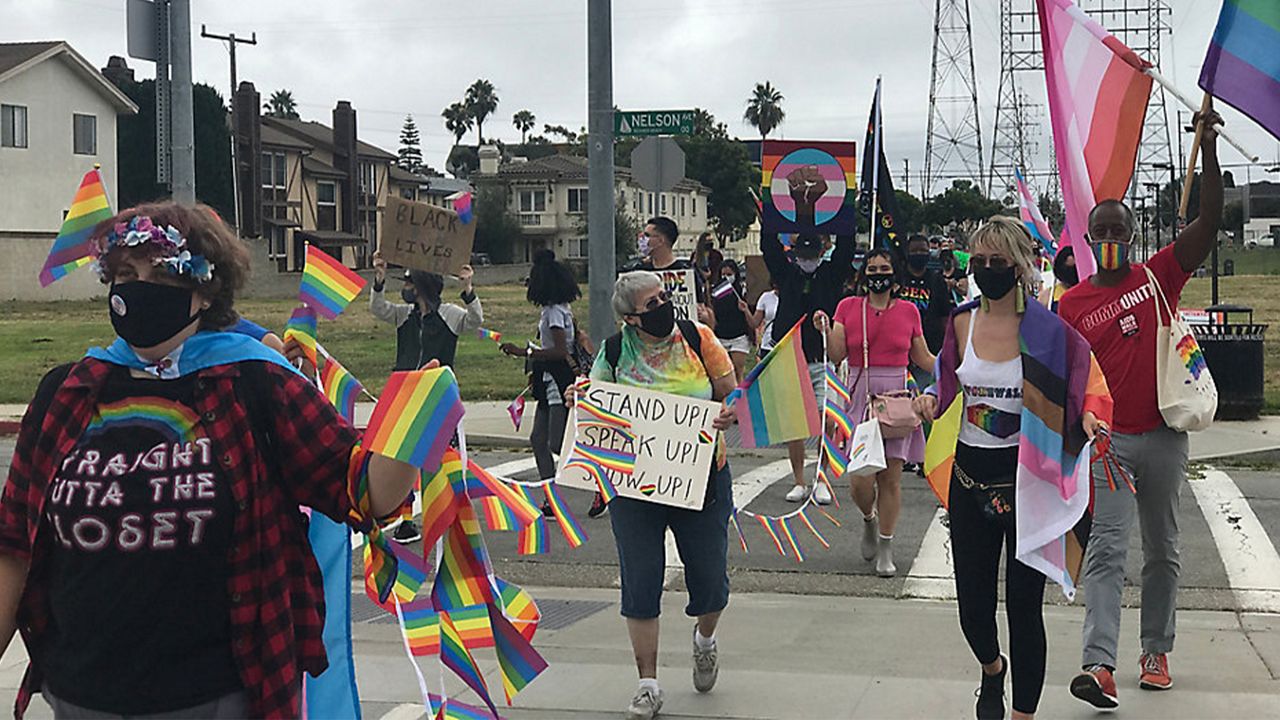REDONDO BEACH, Calif. — It was a grey, almost dreary morning in Redondo Beach on Sunday. Even by 10 a.m., the few people out and about were moseying, taking dogs out on walks, or visiting their neighbors.
A bullhorn rang out, insisting that Black lives, trans lives, and brown lives matter. Bright, colorful flags shook up the neighborhood, and about four dozen people turned the city’s greenbelt into a rainbow belt.
Proud, passionate members of the LGBTQ community, their friends, and their allies turned out for the South Bay Pride March on Sunday, the 50th anniversary of Los Angeles’s first Pride March, and 51 years on from Manhattan’s Stonewall Riots. This march was not a riot, but a one-mile celebration between parks, in the middle of an otherwise sleepy Sunday morning.
Organizers chose the route for a few reasons.
First, the parks at either end of the march were fine gathering points for speeches (organizers also provided masks and hand sanitizer in goodie bags). Second, the city’s greenbelt walking path provided plenty of room for participants to spread out and social distance. Most importantly, they wanted to have genuine neighborhood pride.
“I think it’s easier for someone to go up and march in a protest in Hollywood with 20,000 other people. No one even knows you’re there, not your neighbors, not your church members, not the PTA,” Alphonzo Hicks, president of the South Bay LGBT Center, said. “I think the most important thing, and the thing that has the most impact is when a person is able to march in their own small city for the people in your community to see what you believe in.”
March organizer and Redondo Beach resident Sarah Leinen is not a member of the LGBTQ community herself, but she grew up in a close-knit, diverse “utopia,” she said. It wasn’t until middle school when she realized that the relationship between her neighbors George and Vince was scorned by some people. “It didn’t make sense to me, because they were a representation of love,” she said.
As she grew, she made it a mission to help break down the “du-jour segregation” that the LGBTQ community faces. And when she saw the opportunity to create a neighborhood march in Redondo Beach, she reached out to Hicks — the South Bay LGBT Center is on the other side of Crenshaw Boulevard, almost directly across from El Camino College, where Leinen is a lecturer and a co-advisor for El Camino College’s Gay-Straight Alliance.
“I wanted to do something to not only commemorate that, but to also show solidarity and intersectionality of the fight for equal rights that is coming to a precipice right now,” Leinen says.
The South Bay is a curious case for the LGBTQ community. The region is made up of 19 cities and neighborhoods, approximately 140,000 residents, and one gay bar. That’d be Redondo Beach’s Artesia Bar, once known as the Dolphin. It’s now the last gay bar left standing in the South Bay out of a history of four, according to Dottie Wine, a co-founder of the South Bay LGBT Center. At this point, very little exists for members of the community to be among like-minded people.
Though Hicks believes that the South Bay has a relatively conservative history dating back to its heyday as the military-adjacent “cradle of aerospace,” he’s been pleased to watch when LGBT community members and their allies have made themselves heard. A turning point signifying “that things are changing” came in 2016, when hundreds of people counter-protested the Westboro Baptist Church at Redondo Union High School in 2016.
He was further encouraged by the U.S. Supreme Court’s decision two weeks ago, ruling that the Civil Rights Act of 1964 also protects members of the LGBTQ community from workplace discrimination.
“It’s just one step closer to getting to equality,” Hicks said.
Redondo resident Rita Loy has made herself a fixture of the city for years, following her transition. Loy is a trans woman who came to understand herself late in life. She knew for many years that “something was off” about her life as a man, but didn’t undertake her transition until late 2011. That’s when she hit her breaking point, contemplating suicide. Instead, she came out to her wife, changed her name, and has become a flag-bearing member of the community.
Literally. At Sunday’s parade, she brought a collapsible flagpole of her own, holding the blue, pink, and white Transgender Pride flag high.
For years, Loy has been ever-present in local civic life, regularly attending local meetings and events — a “squeaky wheel,” as she says — to make sure her officials know the people they represent.
“How can people know we exist if we don’t make ourselves known to our local government officials? We passed a sign on the way here listing the mayor, the city council, and a few other officials. They all know me because I make myself known,” Loy says. “Let people know that you exist so that they will acknowledge you. Otherwise, why should they acknowledge you?”



